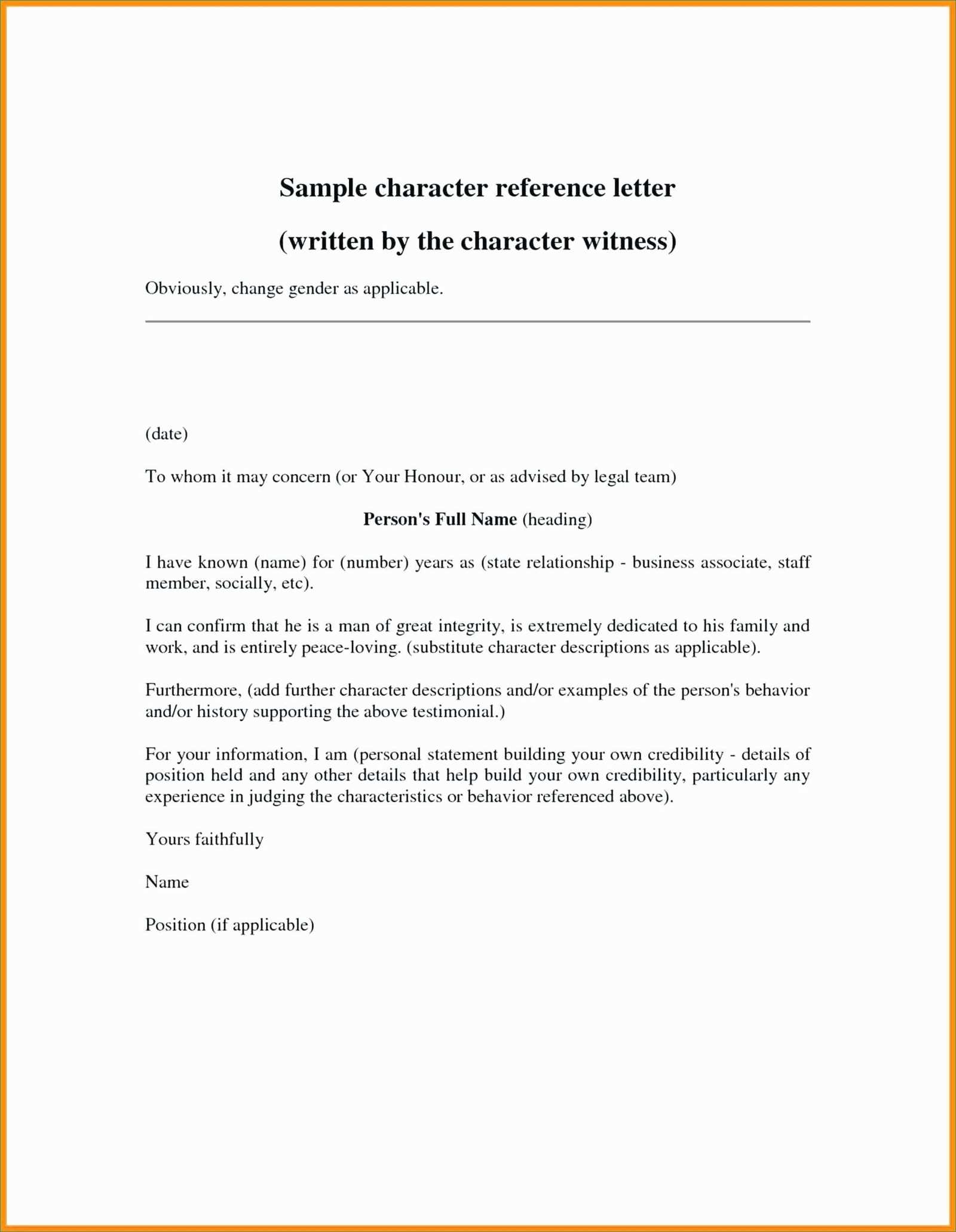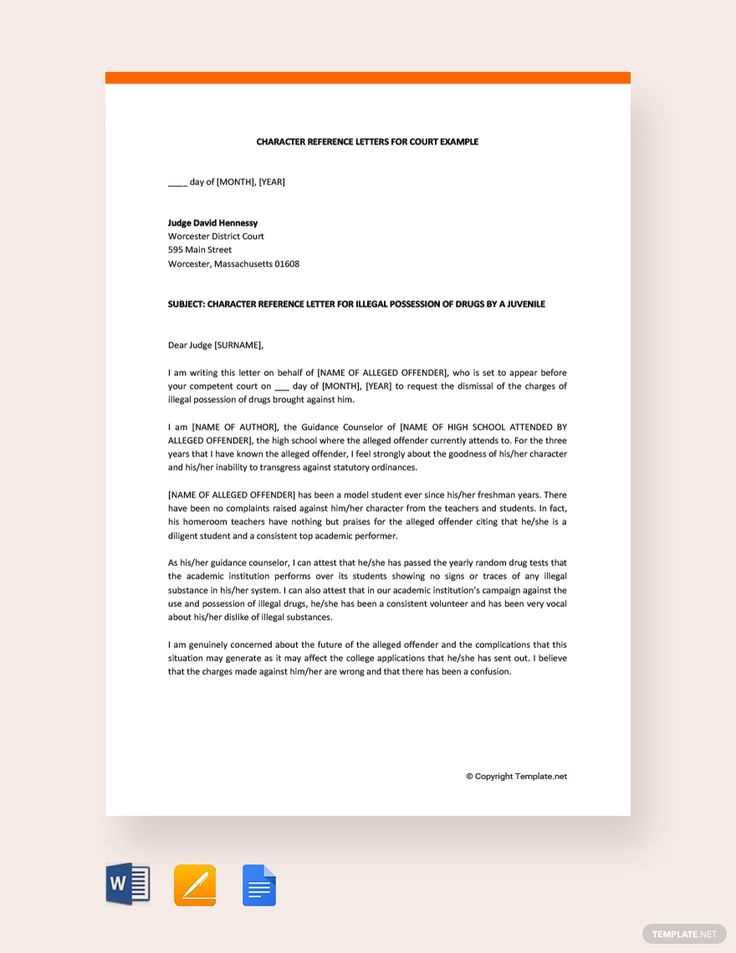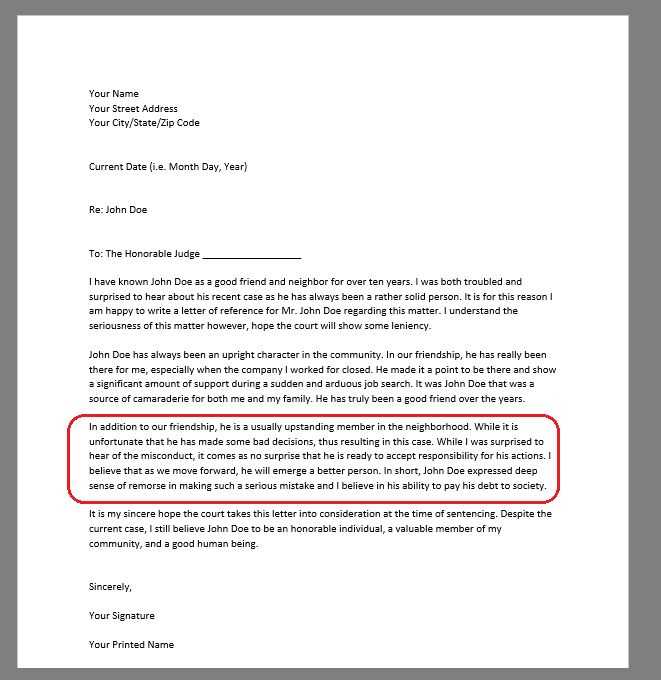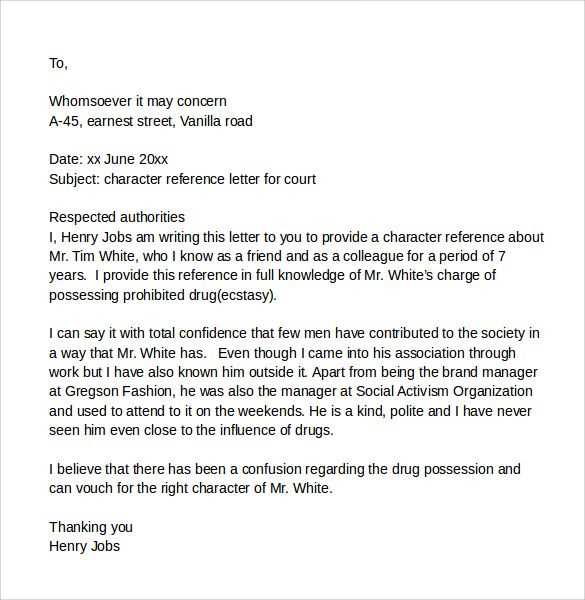Character Letter Template for Court

When facing legal proceedings, one of the ways to provide valuable insight into someone’s character is by offering a written statement from a personal acquaintance. This type of statement can have a significant impact on how a person is perceived during a trial. It allows the writer to share their knowledge of the individual’s integrity, behavior, and general conduct.
It is important that such a statement is both honest and well-crafted, as it can influence important decisions. The format, tone, and content need to reflect a clear understanding of the situation, while providing a truthful representation of the person involved. This guide will walk you through the necessary elements to create a strong and effective document.
Understanding the purpose behind this kind of writing is essential to ensure that your statement serves its intended function. The goal is to offer a fair, supportive, and accurate portrayal of the individual, helping to present them in the most favorable light possible under the circumstances.
Understanding the Importance of Personal References
In legal matters, individuals are often required to present written statements that offer insight into their character and actions. These documents can be vital in shaping the perception of a person involved in a legal case. They provide a chance to showcase an individual’s positive traits and demonstrate their integrity, which can play a crucial role in influencing outcomes.
Impact on Legal Outcomes

The role of such statements is not to replace legal evidence but to add a human perspective to the proceedings. By sharing personal experiences or observations, the writer can highlight qualities such as honesty, responsibility, and remorse, which are often essential in the decision-making process. A well-written statement can help the court understand the individual beyond the legal facts, potentially leading to a more favorable result.
Building Trust and Credibility

These documents help build trust between the person in question and the legal system. When the writer is someone with credibility–such as a community leader, teacher, or employer–the statement carries more weight. It can act as a testament to the individual’s good nature, helping to paint a more complete picture of who they are and how they typically conduct themselves in everyday life.
Key Elements to Include in Your Statement
When drafting a personal reference intended to support someone in a legal situation, it’s essential to include certain key details that will make your statement effective. The content should be clear, concise, and focused on aspects that provide insight into the individual’s integrity and character. By including the right information, you can ensure your words carry weight and contribute positively to the case at hand.
Introduction of Relationship – Start by identifying how you know the individual and for how long. This establishes your credibility as a writer and provides context for your observations. Mention the nature of your relationship, whether personal or professional, and highlight any specific experiences that demonstrate your understanding of their character.
Specific Examples – It’s important to offer concrete examples that illustrate the person’s positive traits. These can include stories or situations where they showed responsibility, compassion, or honesty. Focusing on real-life scenarios makes your statement more relatable and powerful.
Overall Impression – Conclude by summarizing your general opinion of the individual. Express your belief in their good character and potential for positive contributions to society. The final paragraph should reinforce the trustworthiness and integrity of the person in question.
How to Structure Your Personal Reference
When crafting a reference to support someone in a legal matter, it’s important to organize the content in a logical and coherent manner. A well-structured document ensures that your message is clear and impactful. The flow of the text should guide the reader through the necessary details, making it easy to understand the individual’s positive attributes.
Opening and Introduction
Begin with a brief introduction that includes your name, background, and your relationship to the person. This establishes your authority and helps the reader understand your perspective. Be sure to mention how long you have known them and in what capacity, whether as a colleague, neighbor, or friend.
Body and Key Points
The main body of your reference should focus on the qualities that you believe make the individual a good and trustworthy person. Provide specific examples that demonstrate their integrity, kindness, or reliability. Focus on aspects of their behavior that are relevant to the situation at hand, making sure to highlight their character through real-life scenarios.
Finally, finish with a conclusion that restates your belief in their good nature and trustworthiness. A positive and supportive closing statement can help reinforce your position and leave a lasting impression on the reader.
Common Mistakes to Avoid When Writing
When preparing a document intended to support someone in a legal matter, it’s important to communicate effectively and avoid errors that can undermine the message. While drafting, there are several pitfalls that can detract from the clarity and credibility of your words. These mistakes can lead to confusion or misinterpretation, weakening the overall impact of your communication.
1. Lack of Clarity
Being vague or overly complex can make it difficult for the reader to understand the main points. Always strive to express your ideas in a simple and direct manner. Avoid using unnecessary jargon or convoluted phrasing that could cloud the message.
2. Overloading with Irrelevant Details
Including excessive or unrelated information can distract from the core issue. Stay focused on the subject at hand and avoid straying into irrelevant anecdotes or tangents that do not directly support your case.
3. Emotional Language
While it may be tempting to include passionate or emotional expressions, such language can appear biased or unprofessional. Keep the tone formal and neutral, ensuring that the message remains objective and factual.
4. Failure to Proofread
Errors in spelling, grammar, or punctuation can damage your credibility. Always take the time to carefully proofread your work before submitting it. Even small mistakes can give the impression of carelessness, so it’s essential to ensure the document is error-free.
5. Missing Key Information
Omitting important facts or details can lead to misunderstandings. Be thorough in your explanation and ensure all necessary context is provided to support your statements.
Tips for Writing a Persuasive Letter
Crafting a convincing and impactful message requires careful thought and attention to detail. To successfully persuade your reader, it’s essential to organize your ideas clearly, provide strong evidence, and maintain a respectful tone. Follow these tips to enhance the effectiveness of your writing.
- Be Clear and Concise
Stay focused on the main points and avoid unnecessary elaboration. A direct and straightforward approach is often the most powerful way to communicate your message. - Establish Credibility
Make sure your arguments are based on facts or personal experiences that are relevant to the subject. Demonstrating your knowledge and authority on the matter will make your appeal more convincing. - Use Strong, Positive Language
Opt for words that convey confidence and assurance. A positive tone helps reinforce the strength of your position and increases the likelihood of persuading your reader. - Address Possible Concerns
Anticipating objections or questions can strengthen your argument. Show that you’ve considered alternative viewpoints and explain why your perspective is valid. - Maintain a Respectful Tone
While it’s important to be assertive, always remain polite and professional. Respectful communication fosters trust and demonstrates that you are thoughtful and considerate of the reader’s position. - End with a Strong Call to Action
Conclude by urging the reader to take specific action. A clear and decisive ending ensures that your message leaves a lasting impression.
How a Letter Can Impact Court Decisions

A well-written communication can play a significant role in influencing the outcome of a legal proceeding. When presented effectively, it can provide valuable insights into the individual’s character, personal circumstances, and actions that might not be otherwise apparent. These communications can help humanize the person involved, potentially affecting the decision-making process by presenting a fuller picture of their background.
| Aspect | Impact |
|---|---|
| Personal Testimony | Offers first-hand accounts that portray the individual in a positive light, showing their commitment to rehabilitation or personal growth. |
| Support from Others | Demonstrates that the individual is surrounded by a supportive community, which can indicate a likelihood of positive change or responsibility. |
| Contextualizing Actions | Provides context to actions or behavior that may otherwise seem questionable, highlighting mitigating factors that can sway judgment. |
| Appeal to Compassion | Appeals to the emotions of the reader, fostering understanding and empathy for the individual’s situation, which could lead to a more lenient decision. |
| Character Reference | Reaffirms the individual’s positive attributes, reinforcing that they have consistently demonstrated good moral standing. |